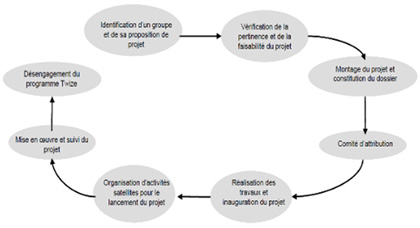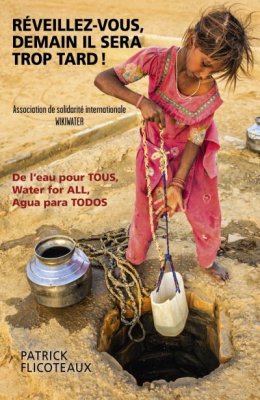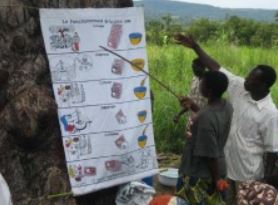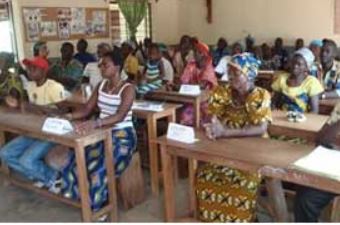1) What is involved ?
As indicated in the two fact sheets C5 and C6, there are various organisations with the purpose of managing water facilities in developing countries.
Here, we shall present two examples of such organisations set up by bodies, which have developed into success stories, with three other examples coming from the International network of CARITAS covered in the previous fact sheet C7.
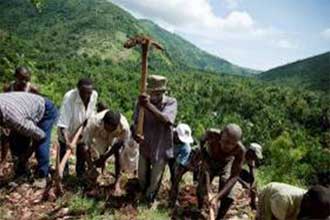
Work carried out benevolently by members of a Management Committee for water distribution in their village
2) First example
The TWIZE urban development programme of GRET in collaboration with the inhabitants in Mauritania
The TWIZE programme (Hassanya term corresponding to solidarity collective work, often carried out by members of the same sex and of the same social category) is an urban development programme implemented by GRET (Group for research and technological exchange) in Mauritania. Thanks to an approach highlighting the role of the leaders, the purpose of the action is to allow the inhabitants to become actors in their development, first by taking stock of the situation and carrying out surveys in the field, prior to leading collective thinking of which the purpose is to manage to set up a process in 4 phases :
1- Know the neighbourhood
Leaders must conduct a survey that is discrete and as complete as possible in order to determine the living conditions of the inhabitants as well as the ways they operate and the power relationships. For this, they can base this on the strong personalities in the neighbourhood and on the conventional methods for discovering these neighbourhoods.
2- Involving the inhabitants
Here too, the "leaders" in the neighbourhoods must be used, taking care that they do not divert the sense of the action to their own profit.
3- Transmitting the messages
Faced with populations whose culture does not assist them in understanding the purely charitable purpose of NGO efforts, leaders must constantly rely on pedagogy and for this, they can get inspiration from the awareness methods such as PHAST or MARP (see fact sheets C2 and C3).
4- Generating and accompanying the initiatives of the inhabitants
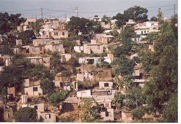 When the inhabitants of the neighbourhood show proof of initiative, the leaders try to assist them in structuring and in organising their projects by providing them with advice and support. Moreover, inhabitants with high potential can be entrusted with carrying out micro projects, according to the operating procedure below :
When the inhabitants of the neighbourhood show proof of initiative, the leaders try to assist them in structuring and in organising their projects by providing them with advice and support. Moreover, inhabitants with high potential can be entrusted with carrying out micro projects, according to the operating procedure below :
Eligibility criteria for micro projects :
- A dynamic, organised and solid driving group.
- A project intended to improve the condition of the life of the inhabitants of the neighbourhood.
- Sufficient financial profitability to cover operating costs.
- A project that is in line with the priorities identified in the development plans of the neighbourhoods and with the objectives of the Twize programme.
- A group able to provide financial participation, in kind or through work in setting up the project and in running it.
- A group able to formalise the project and elaborate a budget with the support of the neighbourhood advisor.
The cycle of the micro project :
Identification of a group and of its suggestion for a project Verification of the pertinence and of the feasibility of the project
Disengagement of the Twize programme Putting the project together and compiling the dossier
Implementation and monitoring of the project Attribution committee
Organisation of satellite activities for the launching of the project Carrying out the work and project inauguration
This example shows that the role of the leader, an indispensable original practice, is relatively complex and that it requires a certain degree of professionalization. It also shows the need to obtain support from local political personalities and from institutions. But above all it shows the variety of solutions and the need to closely associate the population in the elaboration and in the management of the programmes that it is concerned with.
3) Second example
The biennial Inter Aide programme for sustainable access to clean water and sanitation for poor populations in the districts of Loma and Gena-Dawro in Ethiopia.
Context : the districts of loma and Gena-Dawro are rural high mountain regions that are very isolated.
The action carried out by the NGO InterAide in 2006 – supported by the city of Paris and the Seine-Normandy water agency – aimed to provide access to drinking water and sanitation to a poor population of 11,500 people for whom the water consumption was limited to 4 or 6 litres per day and per person, with precarious hygiene conditions. Moreover, another objective was to reinforce the capacities of the communities and institutions in terms of water and sanitation management. Water resources are primarily constituted captive groundwater emerging in the form of altitude springs.
The zone had no sanitation or wastewater evacuation system, and dry latrines existed only in 15% of the families in the region.
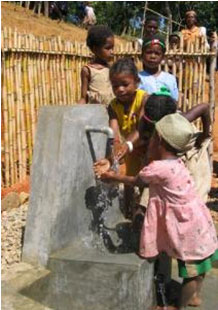
Photo Inter Aide
Description of the action for access to water :
- Construction of 35 gravity-fed water adduction systems conjointly with the Woreda Water Offices (decentralised departments of the State)
- Construction of 1,200 traditional latrines of which 956 latrines created by the inhabitants themselves
- Actions promoting good hygiene gestures and training of users and of the communities in building, using and maintaining water points
- Support from the "Woreda Water Offices" in implementing their maintenance projects ; supply of an initial stock of equipment and transfer of the supervision of the user committees.
Description of the action for the reinforcing of the local capacities :
The implementation of this programme is based on developing synergies between the community and institutional organisations. The project aims for the active intervention of the benefitting communities at the level of the various phases in the project, in particular through their physical participation in carrying out the work and in the setting up of user committees (35 in all). In terms of sustainability, the objective reached was 70% of the committees reaching a level of technical, organisational and financial autonomy after 2 years.
These committees must report on their activities to the State Water Board. A system of contributions will be set up and will be about 3 to 5 Birrs per year which is between €0.30 and €0.50 /year.
This level of contribution can be explained by the fact that the solvency of the inhabitants is particularly low in these regions (threshold for survival per active person of €75/year). Although this type of gravity-fed structure with low-cost maintenance has excellent technical longevity (average survival calculated for 8 years), it does not however immediately encourage the setting up of water services remunerated through a sustainable price.
Finally, the project benefitted 10,300 users, for a total budget of €163,201 over two years. The coverage in access to water increased 4.7% in Loma and 6.6% in Gena-Dawro. The communities largely participated in building the structures and still participate in managing the structures on a daily basis.
Contacts
4) Where to obtain further information
- PS Eau, ASVP (Association of Volunteers for Progress) and EWB (Engineers Without Borders) : long 84-page Mission report "Community management of water distribution systems for secondary centres in Senegal" which contain many passages concerning Management Committees (in particular, pages 11 to 17, 39 to 40 and 55 + Appendix 4 (example of the rules of procedure for a management committee) +, Appendices 5 and 6 (examples of contracts and agreements). Available, online, on : http://www.pseau.org/outils/ouvrage...
- GRET, 80-page report "Leadership in an urban development programme" on the content, method for creating and results of the TWIZE programme described hereinabove (4th example). Available, online, on :
http://www.gret.org/wp-content/uplo...



